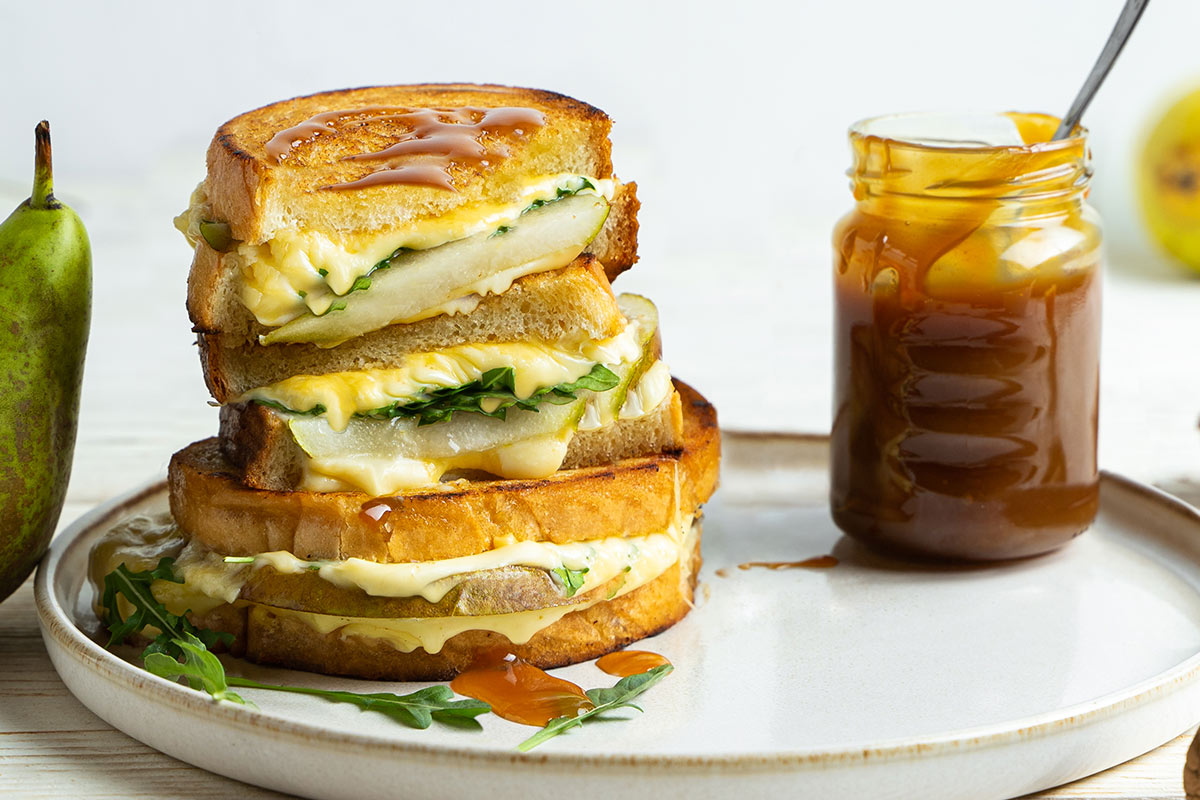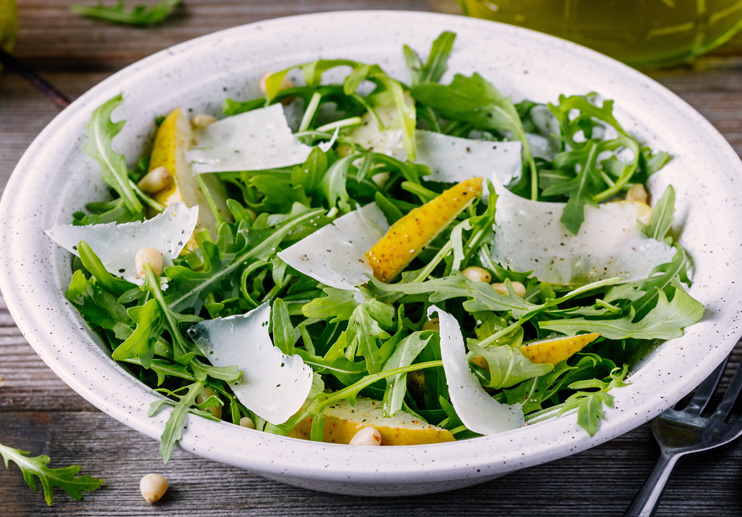Elevated Grilled Cheese Sammies Recipe, Spotlight on Arugula, Avocado and Cast Iron Skillets, and How to Manage Chronic Pain with Exercise
Comfort foods are oh so yummy but often don’t have the best health profile. My version of the classic grilled cheese packs high-nutrient foods that deliver on taste, too. One of them is avocado, a food that’s not only good for you on its own but also seems to encourage healthier eating in general, according to a study I’m sharing. You’ll also read about a healthy therapy to help forestall or ease chronic pain.
Elevated Grilled Cheese Sammies
 Elevated Grilled Cheese Sammies
Elevated Grilled Cheese SammiesEven finicky eaters rush to the kitchen when grilled cheese sandwiches are on the menu. With a few ingredient upgrades, this lunch or dinner mainstay tastes even more delicious.
Ingredients
- Extra virgin olive oil, as needed
- 2 ounces Manchego cheese, shredded
- 1 ripe avocado, cut into thin slices
- 1 ripe pear, cut into thin slices
- 1 tablespoon fig jam
- 1-2 cups arugula
- 4 thin slices crusty whole wheat bread
Directions
Step 1
Brush one side of each slice of bread with olive oil. Build the sandwiches on two of the slices, layering the ingredients equally in this order: a sprinkling of cheese, avocado slices, pear slices, fig jam, arugula, the rest of the cheese, and the top slice of bread.
Step 2
If using a panini press, brush the outsides of the bread with olive oil and heat the press and grill the sandwiches as directed. If using a griddle, heat over medium heat; when hot, add two tablespoons of olive oil in two separate pools and place a sandwich over each pool. Press down on the sandwiches with a large spatula or an empty cast iron skillet (see “Quick Kitchen Nugget” below). When the bottoms have browned, flip the sandwiches and repeat.
Makes 2 servings

Healthy Ingredient Spotlight
Amazing Arugula

We often talk about sensing the spiciness of arugula when doing our fresh-pressed olive oil tastings—the tender greens are full of zesty flavor. If arugula isn’t already on your shopping list, it’s time to add it. The cool weather of spring and fall is its ideal growing environment. Young, or “baby,” arugula is milder in taste—though still peppery—than more mature or late-season harvests.
Though often found in bagged lettuce mixes, arugula (Eruca vesicaria) is actually a cruciferous vegetable, part of the same family as broccoli, cabbage, and kale—and just as packed with nutrients, including antioxidants. In addition to vitamins A, C, K, and folate and the minerals calcium, iron, potassium, and magnesium, arugula has glucosinolates, natural substances that offer some protection from certain types of cancer, such as cancers of the breast, prostate, colon, and lung (glucosinolates are also responsible for that spicy bitterness).
Arugula makes a great addition to hot and cold sandwiches, focaccia, and pizzas—just be sure to add it after your pizza is cooked, or the high temperature of the oven will burn it quickly.
Baby arugula tends to come prerinsed, but when growing your own or buying a bunch from the greengrocer, just before eating submerge the leaves in a large bowl of cool water and agitate them to remove any dirt. Wait two minutes, then scoop out the leaves with a spoon strainer, pat dry, and enjoy.

Quick Kitchen Nugget
Cast Iron Skillet: A Makeshift Panini Press
The value of a panini press is that it grills both sides of a sandwich at once and compacts the contents for better cheesy goodness. But you can achieve a similar effect by placing a cast-iron skillet on top of your sandwich on a griddle or grill. You’ll still have to flip the sandwich, but the skillet’s weight will compress it as it toasts on each side. If you use this method, don’t brush the top outer piece of bread with oil until you’re ready to flip it, to keep the oil from transferring to the skillet.

For Your Best Health
An Avocado a Day…
A group of researchers from Wake Forest University School of Medicine, Tufts University, the David Geffen School of Medicine at the University of California Los Angeles, Loma Linda University, and Penn State University examined how the food-based intervention of eating one nutrient-dense avocado per day could impact overall diet quality. Surprisingly, only 2% of American adults eat avocados on a regular basis, even though they’re high in fiber and healthy fats, among many other nutrients. The study was published in the journal Current Developments in Nutrition.
“Previous observational research suggests avocado consumers have higher diet quality than non-consumers. So, we developed this study to determine if there is a causational link between avocado consumption and overall diet quality,” said Kristina S. Petersen, PhD, associate professor of nutritional sciences at Penn State.
For the research, 1,008 participants were split into two groups. One group continued their usual diet and limited their avocado intake during the 26-week study, while the other group incorporated one avocado per day into their diet.
Researchers conducted phone interviews with participants before the study began and at a few points throughout to determine what their dietary intake was like in the previous 24 hours and evaluated their diets using the Healthy Eating Index to see how well they adhered to the Dietary Guidelines for Americans, which was used as a measure of overall diet quality.
“We found that the participants who had an avocado per day significantly increased their adherence to dietary guidelines,” Dr. Petersen said. “By improving people’s adherence to dietary guidelines, we can help to reduce their risk of developing chronic conditions and prolong healthy life expectancy.…In our study, we classified avocados as a vegetable and did see an increase in vegetable consumption attributed to the avocado intake, but also participants used the avocados to replace some unhealthier options…as a substitute for some foods higher in refined grains and sodium.”
Dr. Petersen has conducted similar studies investigating the impact of food-based interventions, including the relationship between pistachios and diet quality. She added that more research is needed to determine what other food-based strategies and behavioral strategies could also be used to improve adherence to dietary guidelines.

Fitness Flash
Physical Activity for Chronic Pain Protection
Researchers from UiT The Arctic University of Norway, the University Hospital of North Norway (UNN), and the Norwegian Institute of Public Health knew from an earlier study of more than 10,000 adults that those who were physically active had a higher pain tolerance than those who were sedentary—and the higher the activity level, the higher the pain tolerance. They next wanted to understand how physical activity could affect the chances of experiencing chronic pain years later and whether this is related to how physical activity affects our ability to tolerate pain. So, they embarked on new research involving almost 7,000 people recruited from the large Tromsø survey, the Norwegian database that has collected data on people’s health and lifestyle over decades.
They obtained information about the participants’ exercise habits during their free time and whether they experienced pain that lasted for 3 months or more, including widespread or severe pain.
“We found that people who were more active in their free time had a lower chance of having various types of chronic pain 7-8 years later. For example, being just a little more active, such as going from light to moderate activity, was associated with a 5% lower risk of reporting some form of chronic pain later,” said doctoral fellow Anders Årnes at UiT and UNN, one of the researchers behind the study. He adds that for severe chronic pain in several places in the body, higher activity was associated with a 16% reduced risk.

The researchers found that the ability to tolerate pain played a role in this apparent protective effect. “This suggests that physical activity increases our ability to tolerate pain and may be one of the ways in which activity helps to reduce the risk of severe chronic pain,” said Årnes.
When it comes to exercising if you already have chronic pain, the researcher said: “Physical activity is not dangerous in the first place, but people with chronic pain can benefit greatly from having an exercise program adapted to help them balance their effort so that it is not too much or too little. Healthcare professionals experienced in treating chronic pain conditions can often help with this. A rule of thumb is that there should be no worsening that persists over an extended period, but that certain reactions in the time after training can be expected.”
The research, “Does pain tolerance mediate the effect of physical activity on chronic pain in the general population? The Tromsø Study,” was published in the journal Pain.
Get More Recipes In Your Inbox!